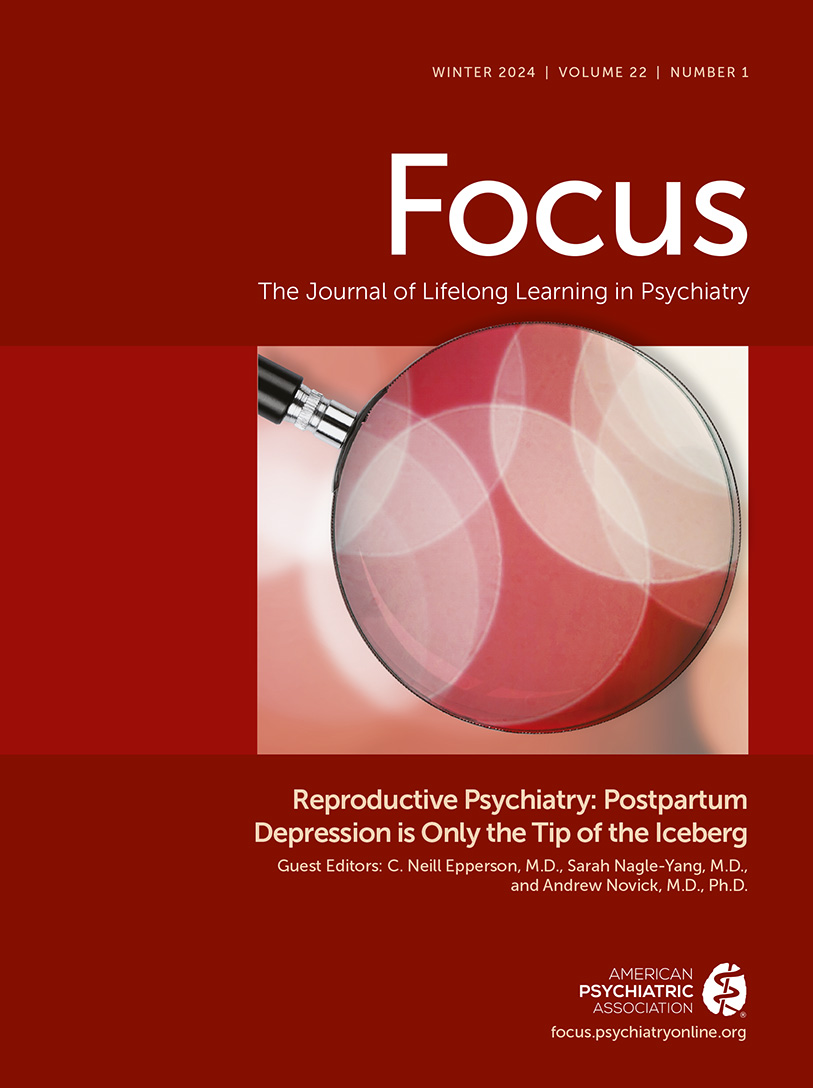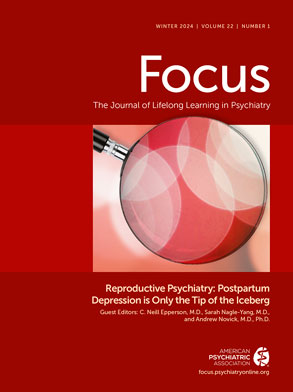Management of Premenstrual Dysphoric Disorder: A Scoping Review
Abstract
Introduction
Diagnosis
| Diagnostic and Statistical Manual of Mental Disorders, Fifth Edition: Premenstrual Dysphoric Disorder1 |
|---|
| A. In the majority of menstrual cycles, at least five symptoms must be present in the final week before onset of menses, start to improve within few days after onset of menses, and become minimal or absent in week postmenses. |
| B. One (or more) of the following symptoms must be present: |
| 1. Marked affective lability (eg, mood swings; feeling suddenly sad or tearful or increased sensitivity to rejection). |
| 2. Marked irritability or anger or increased interpersonal conflicts. |
| 3. Marked depressed mood, feelings of hopelessness, or self-deprecating thoughts. |
| 4. Marked anxiety, tension, and/or feelings of being “keyed up”, or “on edge”. |
| C. One (or more) of the following symptoms must additionally be present, to reach a total of five symptoms when combined with symptoms from Criterion B above: |
| 1. Decreased interest in usual activities (eg, work, school, friends, hobbies). |
| 2. Subjective difficulty in concentration. |
| 3. Lethargy, easy fatigability, or marked lack of energy. |
| 4. Marked change in appetite, overeating, or specific food cravings. |
| 5. Hypersomnia or insomnia. |
| 6. A sense of being overwhelmed or out of control. |
| 7. Physical symptoms such as breast tenderness or swelling, joint or muscle pain, sensation of “bloating”, weight gain. Note: The symptoms in Criteria A–C must have been met for most menstrual cycles that occurred in the preceding year. |
| D. The symptoms are associated with clinically significant distress or interferences with work, school, usual social activities, or relationships with others (eg, avoidance of social activities, decreased productivity and efficiency at work, school or home). |
| E. The disturbance is not merely an exacerbation of the symptoms of another disorder such as major depressive disorder, panic disorder, persistent depressive disorder (dysthymia), or a personality disorder (although it may co-occur with any of these disorders). |
| F. Criterion A should be confirmed by prospective daily ratings during at least 2 symptomatic cycles. (Note: The diagnosis may be made provisionally prior to this confirmation.) |
| G. The symptoms are not attributable to the direct physiological effects of a substance (eg, a drug of abuse, a medication other treatment) or another medical condition (eg, hyperthyroidism). |
| International Society for Premenstrual Disorders: Core Premenstrual Disorder7 |
| 1. Symptoms occur in ovulatory cycles. |
| 2. Symptoms are not specified – they may be somatic and/or psychological. |
| 3. The number of symptoms is not specified. |
| 4. Symptoms are absent after menstruation and before ovulation. |
| 5. They must recur in luteal phase. |
| 6. They must be prospectively rated (two cycles minimum). |
| 7. Symptoms must cause significant impairment. |
Epidemiology and Morbidity
Pathophysiology
Rationale and Objectives
Methods

Treatment Review
Medication
SSRIs.
| Medication | Dose Range | Dosing Schedule |
|---|---|---|
| Sertraline | 50 mg to 100 mg daily30,31 | Luteal phase |
| | 50 mg to 100 mg daily49 | Symptom-onset |
| Escitalopram | 10 mg to 20 mg daily32 | Luteal phase |
| | 10 mg to 20 mg daily33 | Symptom-onset |
| Paroxetine | 10 mg to 20 mg daily36,37 | Luteal phase |
| | 12.5 mg to 25 mg daily (controlled release)38–40 | |
| Fluoxetine | 10 mg to 20 mg daily41 | Luteal phase |
| Venlafaxine | 75 mg to 112.5 mg daily51 | Luteal phase |
Serotonin–norepinephrine reuptake inhibitors (SNRIs).
Combined oral contraceptives (COCs).
Progesterone.
Estrogen.
Androgens.
Gonadotropin releasing hormone (GnRH) receptor agonists.
Anxiolytics.
Other medications.
Novel/investigational therapeutics.
Complementary and Alternative Medicine
| Medication | Dose |
|---|---|
| Vitex Agnus-Castus | 8 mg to 41 mg daily107–109 |
| Kami-shoyo-san | 2.5 g three times per day113 |
| Saffron | 15 mg twice daily114,115 |
| Hypericum perforatum | 600 mg daily117 |
| Chamomile | 100 mg to 400 mg daily110 |
| Vitamin B6 (pyridoxine) | 50 mg to 100 mg dailya,118,119 |
| Vitamin B1 (thiamine) | 100 mg daily122,123 |
| Vitamin D | *b |
| Calcium | 500 mg to 1200 mg daily127–130 |
| Zinc (elemental) | 30 mg to 50 mg daily131,132 |
| Magnesium | 250 mg daily134,135 |
| Omega 3 fatty acids | 500 mg to 2000 mg dailyc,137 |
| Myo-inositol | 0.6 mg in gel capsule138 |
| 2 g in powder138 |
Herbal preparations.
Vitamins.
Minerals.
Other dietary supplements.
Proprietary blends.
Non-pharmacological CAM.
Psychotherapies
Surgery
Hysterectomy with Bilateral Salpingectomy/Oophorectomy (BSO).
Endometrial ablation.
Discussion
Limitations
Conclusion
References
Information & Authors
Information
Published In
History
Keywords
Authors
Funding Information
Metrics & Citations
Metrics
Citations
Export Citations
If you have the appropriate software installed, you can download article citation data to the citation manager of your choice. Simply select your manager software from the list below and click Download.
For more information or tips please see 'Downloading to a citation manager' in the Help menu.
View Options
View options
PDF/EPUB
View PDF/EPUBLogin options
Already a subscriber? Access your subscription through your login credentials or your institution for full access to this article.
Personal login Institutional Login Open Athens loginNot a subscriber?
PsychiatryOnline subscription options offer access to the DSM-5-TR® library, books, journals, CME, and patient resources. This all-in-one virtual library provides psychiatrists and mental health professionals with key resources for diagnosis, treatment, research, and professional development.
Need more help? PsychiatryOnline Customer Service may be reached by emailing [email protected] or by calling 800-368-5777 (in the U.S.) or 703-907-7322 (outside the U.S.).

